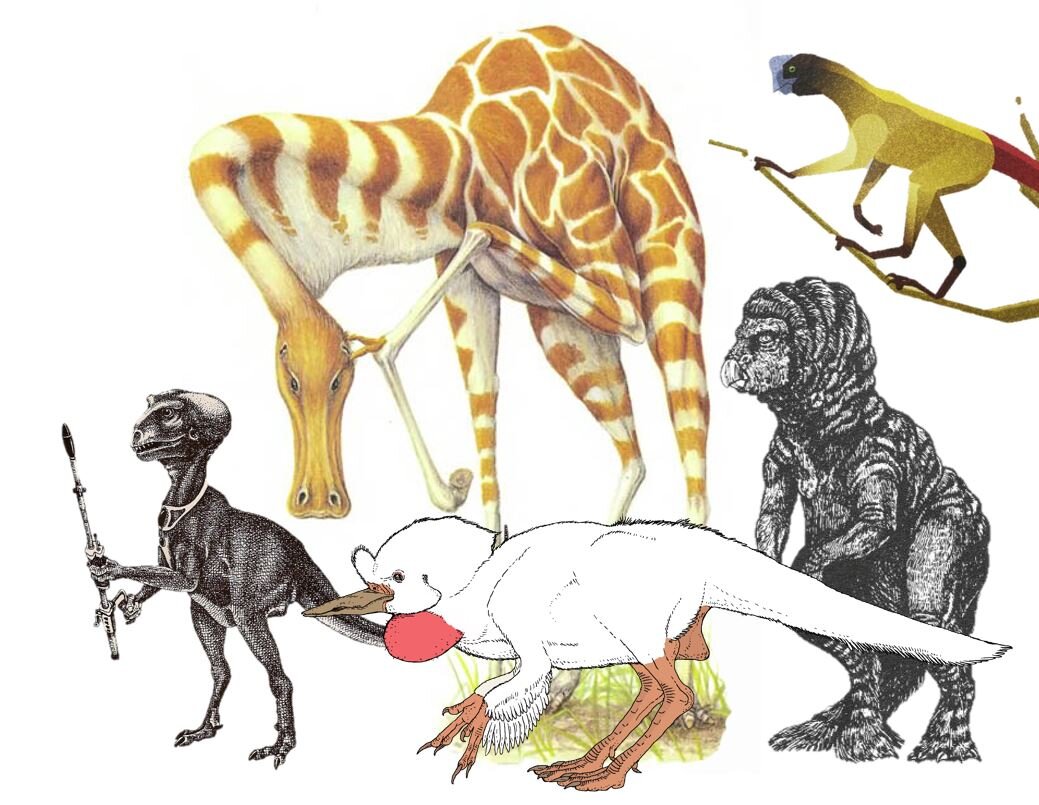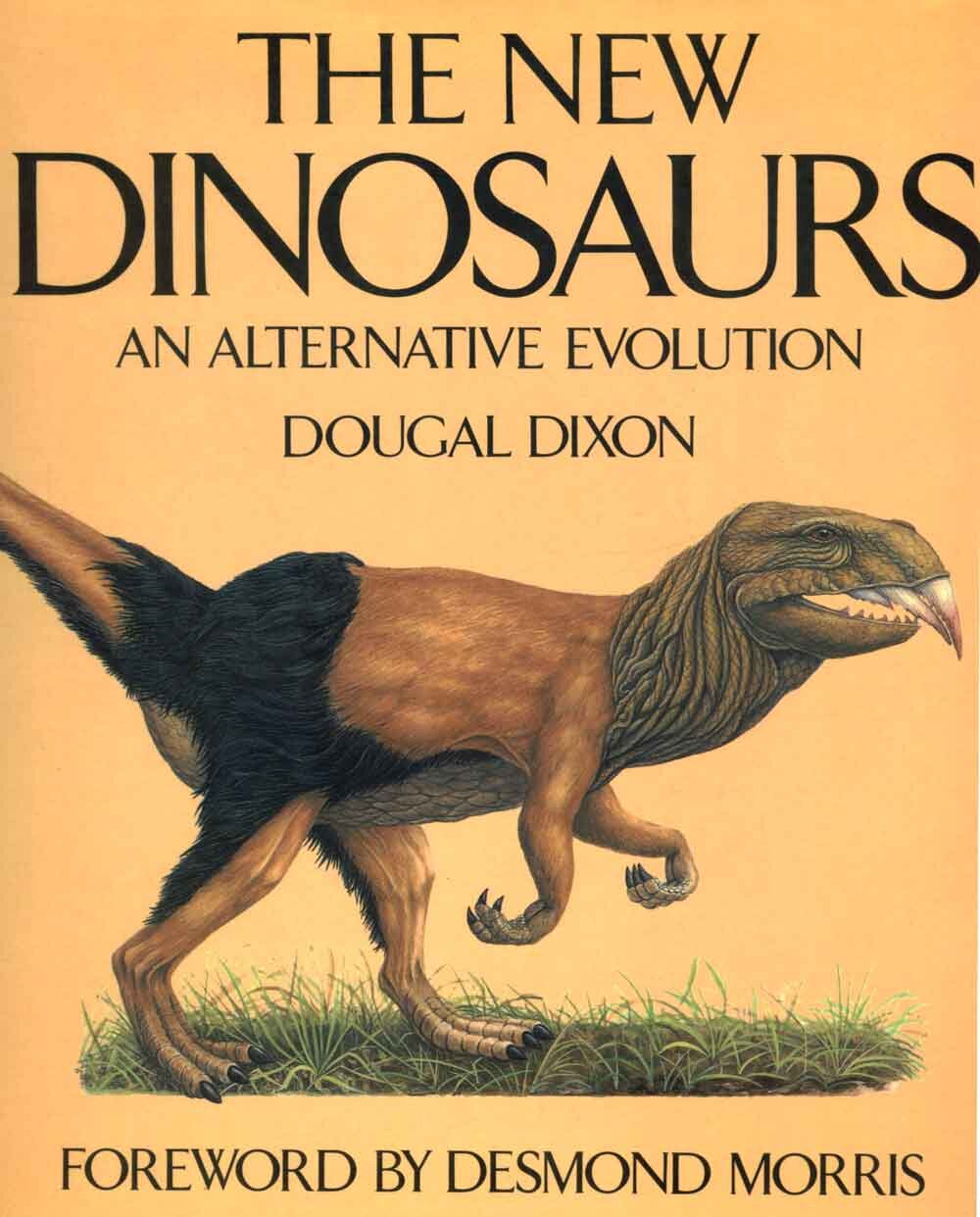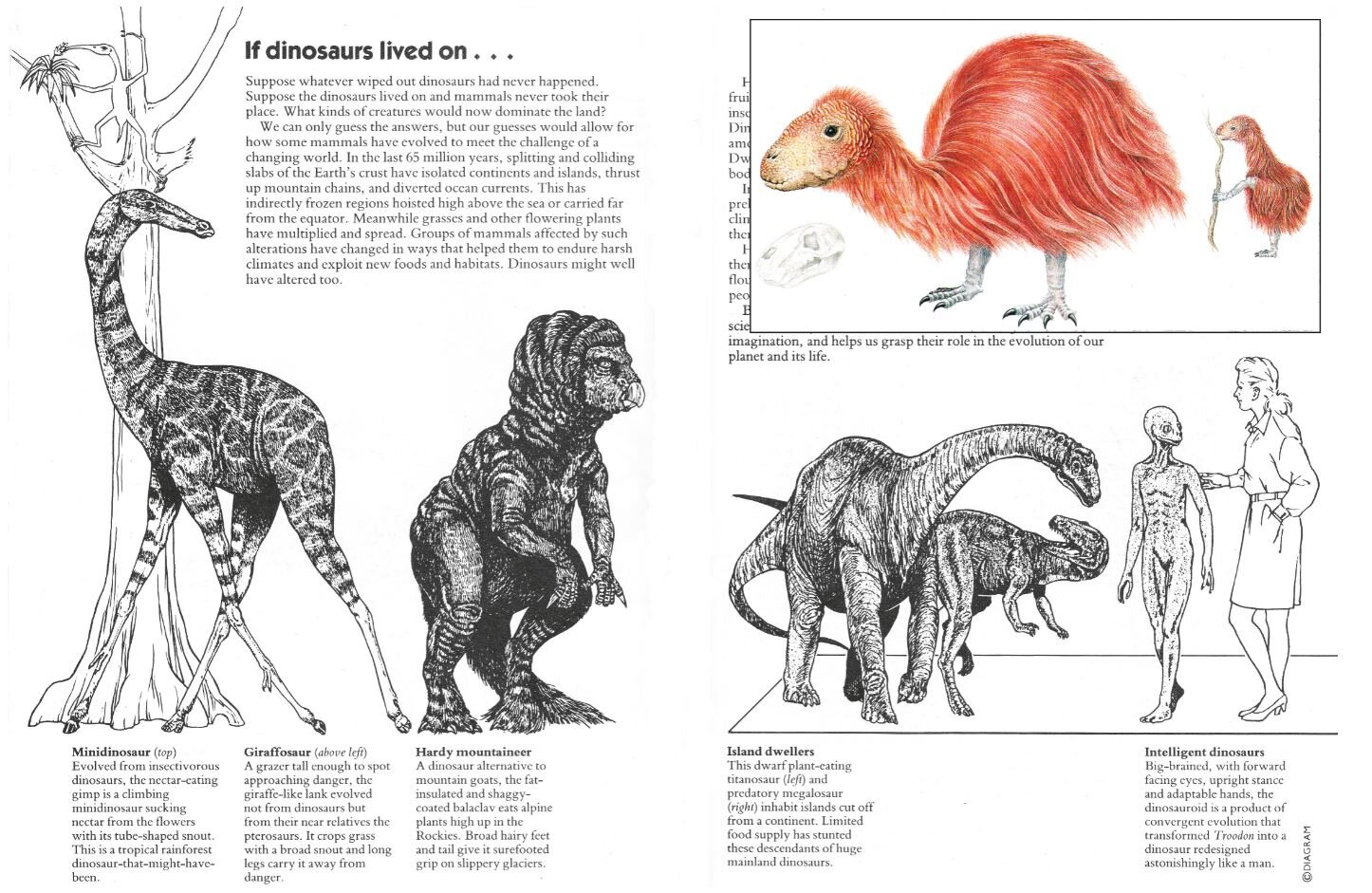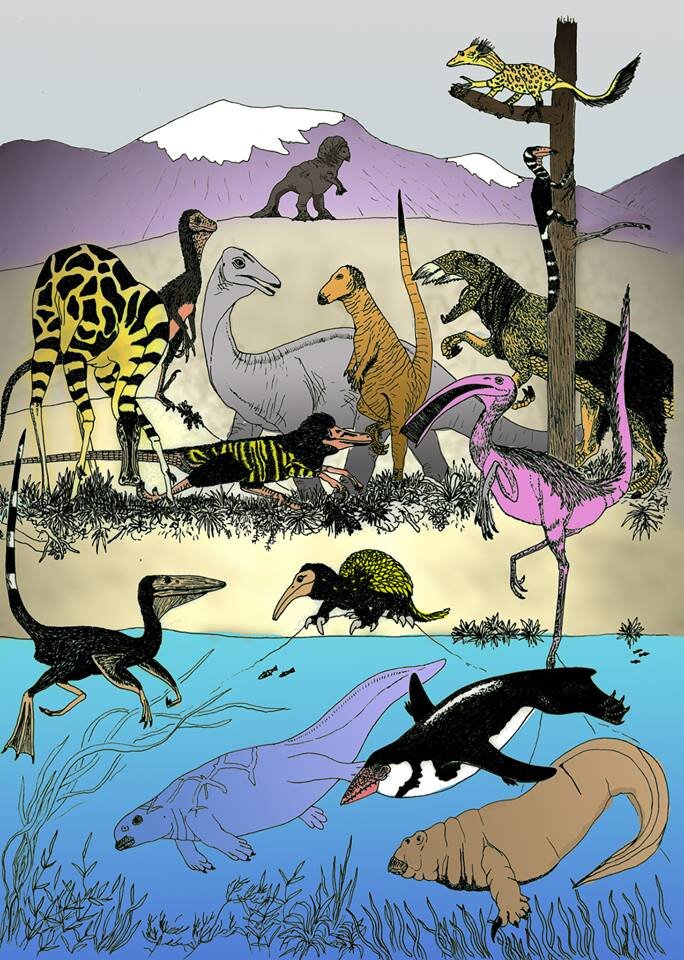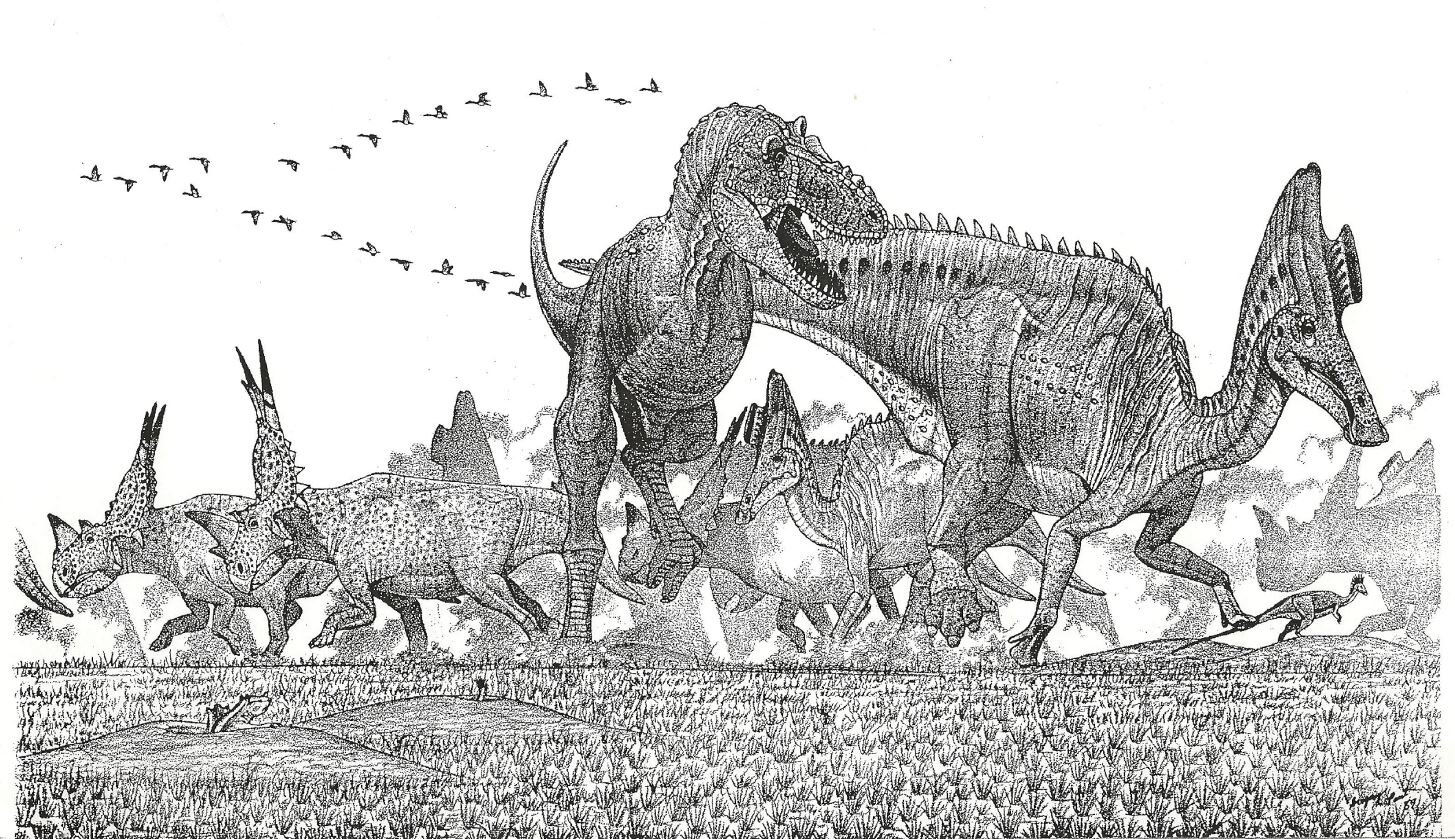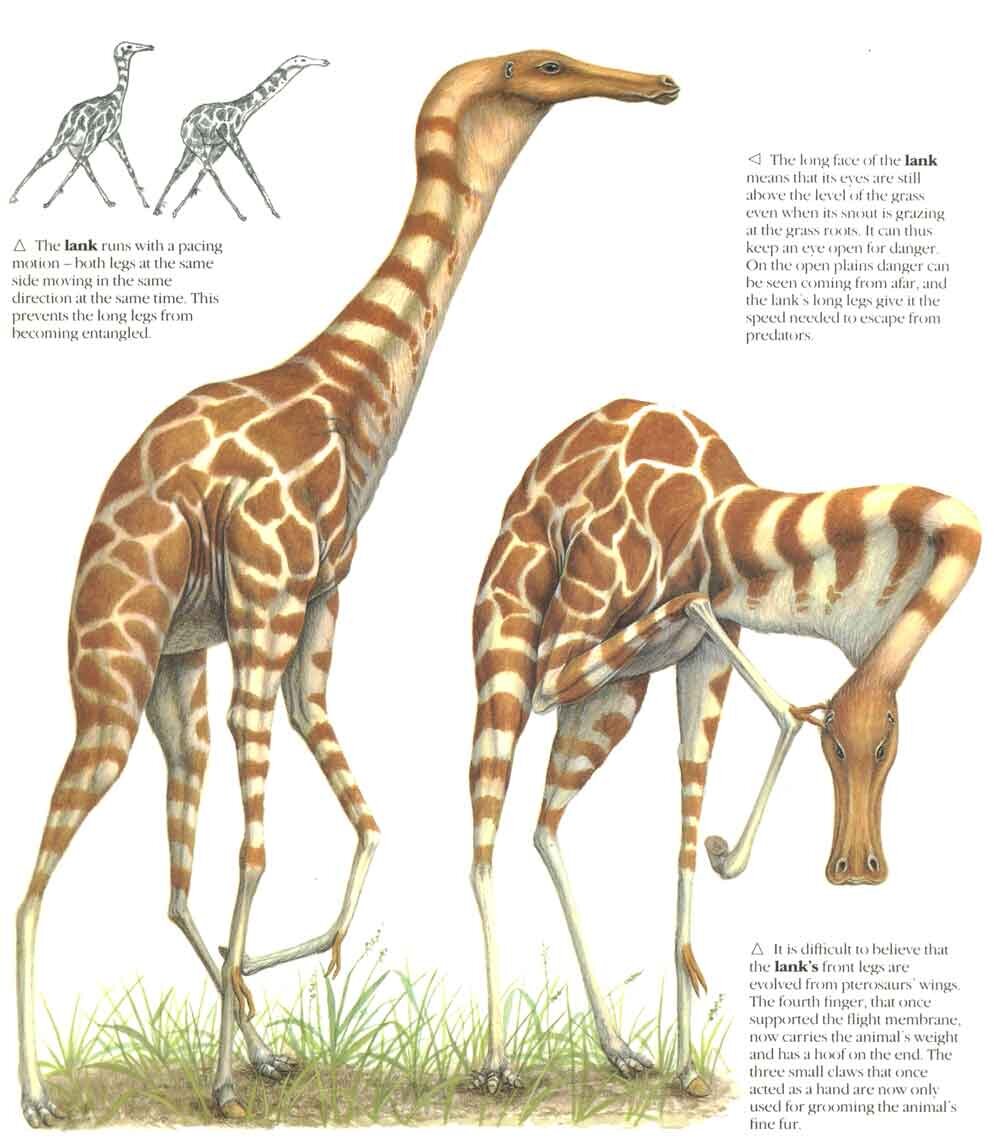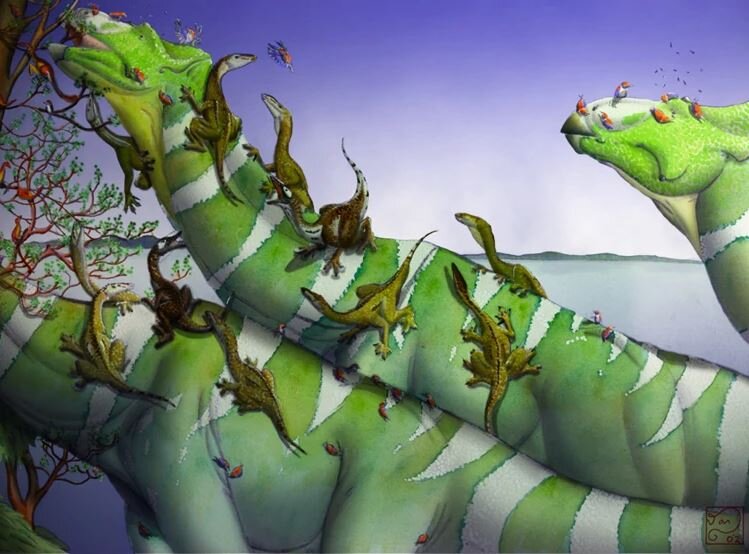Speculative Biology, Speculation Zoology and Speculative Evolution (technically speaking, they’re not all the same one thing) have been perennially popular here at TetZoo, and I think it’s fair to say that interest in these issues is currently at an all-time high. And among the various branches of the SpecVerse that enjoy the most attention and interest is that concerning Alternative Timeline Dinosaurs… and pterosaurs, and marine reptiles, and their contemporaries. These being those hypothetical animal lineages that might have evolved in a timeline where the end-Cretaceous extinction event (properly the KPg Event) didn’t occur.
Caption: a montage of speculative dinosaurs, and one pterosaur. From left to right: McLoughlin’s Bioparaptor, Dixon’s Lank (at back), Kosemen’s Avisapiens, Dixon’s Balaclav, and a tree maniraptoran from Pickrell’s 2019 article. Some of these animals will be discussed in future TetZoo articles.
Such is the popularity of alternative timeline dinosaurs that new articles, opinions, ideas and artworks devoted to them are published on a fairly regular basis. At least some of these projects tend not – in my opinion – to give appropriate credit or mention to what’s happened before, but others certainly do. My aim in this article here (and its successors, to be published later this year) is to discuss most of the key ideas that have been covered in takes on alternative timeline dinosaurs, and to review and cite relevant literature old and new. To work.
Caption: the benchmark in the world of alternative timeline dinosaurs is this book, appearing in 1988… the same year that one or two other influential books on dinosaurs appeared in print (looking at you, Predatory Dinosaurs of the World). Image: Darren Naish.
It’s fair to say that hypothetical post-Cretaceous non-bird dinosaurs have featured in fictional scenarios for almost as long as non-bird dinosaurs have been known to science, such that they star in the works of Arthur Conan Doyle, Edgar Rice Burroughs and others since well prior to the dinosaur renaissance. As significant as these works are, however, they mostly don’t get classed as SpecZoo given that they aren’t contingent on the idea that the animals have changed since Mesozoic times. With that in mind, we mostly owe the genesis of the alternative timeline dinosaur trope to two pieces of literature: Dougal Dixon’s The New Dinosaurs: An Alternative Evolution of 1988, and Dale Russell and Ron Séguin’s 1982 Syllogeus article on hypothetical big-brained theropods.
Caption: my introduction to alternative timeline speculative dinosaurs was in part thanks to David Lambert’s Dinosaur Data Book (Lambert 1990), which features this really nice montage: there are Dixonian dinosaurs from The New Dinosaurs, and Russell and Séguin’s dinosauroid at far right. The brief BBC Wildlife magazine ad on The New Dinosaurs - featuring the Kloon (top right) - also caught my imagination. For all kinds of reasons, I never saw The New Dinosaurs in bookshops. Images: Dixon 1988, Lambert 1990.
Dixon (1988) – the sequel to Dougal’s hugely successful and highly popular After Man of 1981 – portrays a modern world where dinosaurs, pterosaurs, plesiosaurs and other groups occupy the roles taken today by placental and marsupial mammals, as well as by various snakes, birds and so on. I won’t start reviewing the pantheon of creatures covered in the book here, but the illustrations below gives some idea of what we get.
Caption: a montage that depicts various of the creatures of Dougal Dixon’s TND. We see here a combination of flightless pterosaurs, climbing and terrestrial, predatory theropods, aquatic ornithischians, amphibious pterosaurs and theropods, and others. These illustrations are redrawn from those featured in Dixon (1988). Image: Darren Naish, colouring by Ethan Kocak.
I think it’s fair to say that The New Dinosaurs (TND) enjoyed a mixed response, with some reviewers hating it and others praising it (e.g., Gee 1988, Tudge 1988, Unwin 1992). The most interesting and detailed review (and, for a long time, the most difficult to obtain) is that by Greg Paul (1990). Paul was highly critical (perhaps ironically, given that his own writings and illustrations were partly inspirational) and made the interesting point that some of the most embracing of Dougal Dixon’s colleagues – Desmond Morris was one of them (he wrote the foreword) – were neither palaeontologists nor especially connected to studies of Mesozoic life. A bonus feature of Paul’s review is that it includes a novel illustration depicting his own take on alternative timeline dinosaurs, his ideas (Paul 1990) being interesting and innovative enough that they’ve inspired more recent views, on which read on.
Caption: alternative timeline dinosaurs of the modern era, as imagined by Greg Paul (1990). Plains-dwelling hadrosaurs and ceratopsians are hunted by cursorial tyrannosaurs. They live alongside small, cud-chewing bipedal ornithischians, burrowing mammals and geese. Image: (c) Greg Paul.
But enough on the critical reception. If anything, the pendulum has swung the other way in recent years, it being increasingly recognised that at least some of the creatures invented for TND were actually insightful and predictive. The Lank – a flightless, giraffe-like, striding pterosaur adapted to life on the grasslands – now appears oddly prescient in view of our thoughts on the ecology and lifestyle of the long-limbed, terrestrially competent azhdarchids (Witton & Naish 2008), and I wrote a 2008 article making this point. The well insulated, cool climate maniraptoran theropods and chubby, insulated ornithischians of TND also no longer look as weird as they might have in 1988 given recent fossil finds, and real-world discoveries like alvarezsaurids, scansoriopterygids, Halszkaraptor and Liaoningosaurus certainly have a Dixonian vibe to them. This was Riley Black’s point, made in this 2011 article at Laelaps.
Caption: the Lank has sometimes been criticised as one of the worst creatures of TND. But maybe this isn’t at all fair… Image: (c) Dixon 1988/Steve Holden.
Of Manga and SpecWorld. There are two other things worth saying about TND before we move on. One is that several of the species in the book appeared in a 2006 Manga volume, illustrated by Takaaki Ogawa (Dixon & Ogawa 2009). I tweeted about the book here; it’s hard to get but is a must-have if you’re a serious SpecZoo aficionado.
Caption: at left, the cover of Dixon & Ogawa (2009). At right, one of the several colour pieces included within. Images: (c) Dixon & Ogawa (2009).
The stories in the book are great fun (and you don’t need to read Japanese to follow them), but often very odd because they show the animals of the book living alongside, and interacting with, real-world animals, including crows, arapaima and Passenger pigeons Ectopistes migratorius! That’s a no-no if we’re keeping to canon, since TND actually describes a world where ‘Mesozoic’ animals have evolved to fill the niches occupied in our timeline by other animals. The second thing worth saying is that Dougal’s visions of alternative timeline dinosaurs inspired others to do the same, but in different fashion.
Caption: scenes from Dixon & Ogawa (2009), one from a Harridan-themed story (the Harridan is a raptor-like, mountain-dwelling pterosaur), and one from an Amazon-themed story involving a Pangaloon and a Watergulp. Images: (c) Dixon & Ogawa (2009).
The Speculative Dinosaur Project kicked off in 2001 and involved the invention of a substantial number of speculative animals. The website is impressive and well designed, and it’s clear that a lot of thought and discussion went into the various animals. They include long-legged, often shaggy-coated tyrannosaurs, the artiodactyl-esque ungulapedes, the sometimes gigantic cenoceratopsians (which, like Greg Paul’s alt-timeline ceratopsians, descend from non-ceratopsid ceratopsians) and many others. There’s always been talk of a Speculative Dinosaur Project book, interest in the site remains high, and there are indications right now from various minor tweaks and updates that it might be undergoing an upgrade or something sometime soon.
Caption: brilliant artwork appears throughout the Speculative Dinosaur Project. This illustration depicts a group of Eastern balundaurs, with mulongs, perfects and jaubs in attendance. Image: CC BY-SA 2.5, Speculative Dinosaur Project (original here).
A nice thing about the Speculative Dinosaur Project is that it never was devoted to non-bird dinosaurs alone, but also covered birds, crocodylomorphs, squamates and mammals in appropriate detail too. In fact, the pages on those groups were among the best parts of the site. This leads us nicely to the next area I want to discuss.
Don’t Ignore the Mammals. Of the several questions always asked in discussions about alternative timeline dinosaurs, one is ‘would humans have evolved, even in a world still dominated by non-bird dinosaurs?’. This is a good question, even if its motivation is that we might get to imagine medieval knights using dinosaurs as mounts, a line of armour-plated war ceratopsians at the Battle of Ipsus, or wonder about the role of giant dinosaurs as beasts of burden or quarry hunted by intrepid human bands equipped with specialised weapons.
The human/dinosaur coexistence thing formed the focus of a 2019 Italian magazine article by Giovanni Camardo (Camardo 2019) – titled ‘If they hadn’t died out, who would have won: us or them?’ – for which I was interviewed (the full text of my interview – in Italian – is here).
Caption: opening pages of Camardo (2019). By now, James Keuther’s CG dinosaurs might be somewhat familiar (I’ve worked with James on several projects, most notably various recent Dorling Kindersley books). UPDATE: thanks to Caleb W. (see comments), I now know that the the model was created by Raul Lunia, but then used by others. Image: (c) Focus magazine.
My suggestion – which was inspired by the Greg Paul article discussed above – is that the Cretaceous record of fossil mammals shows us both that interesting things were happening in mammal evolution late in the Mesozoic, and that at least some of the major mammal lineages were already in existence before the end of the Cretaceous. Ergo, at least some of the things that happened for real in our own timeline might still have happened in a dinosaur-dominated post-Cretaceous world. Because non-bird dinosaurs would have occupied most terrestrial niches in post-Cretaceous world, it might – I suggest, with caveats – have been difficult or impossible for mammals to get an evolutionary toehold at large body size (say, above 30-40kg or so). I’m going to call this the no megamammals rule (we’ll come back to it in the next article).
Caption: the Speculative Dinosaur Project was and is particularly good on mammals. Here are two I chose at random: the Amazonian Nekopossum (left) and the apocryphal Drop-bear, also native to South America (unlike our own timeline’s Drop-bear). Image: Speculative Dinosaur Project.
Lineages producing species below this size, however, could still have evolved pretty much as they did in our own timeline. Which means that burrowing, swimming, climbing, gliding and flying mammals – monotremes, placentals and marsupials – might still have evolved in a dinosaur-dominated world, and that a post-Cretaceous world dominated by dinosaurs might still have pangolins, shrews, moles, bats…. and primates. And if there are primates, there might still be tarsiers, lemurs, monkeys and even apes. And if there are apes, could there be the apes we call humans?
This is where we’ll pick up next. Come back soon for Part II.
For previous TetZoo articles on alternative timeline dinosaurs and related issues of SpecZoo, see…
Dinosauroids revisited, November 2006
Dinosauroid cave art discovered, March 2007
How intelligent dinosaurs conquered the world, March 2008
Come back Lank, (nearly) all is forgiven, September 2008
Belatedly, Nemoramjetia (= Avisapiens), November 2008
Richard Dawkins and the crappy 'humanoid dinosaurs' that just won't die, November 2009
Dinosauroids revisited, revisited, October 2012
Of After Man, The New Dinosaurs and Greenworld: an interview with Dougal Dixon, April 2014
Speculative Zoology, a Discussion, June 2018
Could We Domesticate (Non-Bird) Dinosaurs?, August 2018
The Dougal Dixon After Man Event of September 2018, September 2018
TetZoo Bookshelf, February 2019, Part 1, February 2019
Refs - -
Camardo, G. 2019. Se non si fossero estinti, avremmo vinto noi o loro? Focus 317, 51-55.
Dixon, D. 1988. The New Dinosaurs: An Alternative Evolution. Salem House Publishers, Topsfield, MA.
Dixon, D. & Ogawa, T. 2009. The New Dinosaurs. Futanasha, Tokyo.
Gee, H. 1988. Tales of future past. Nature 335, 505-506.
Lambert, D. 1990. Dinosaur Data Book. Facts on File, New York.
Paul, G. S. 1990. An improbable view of Tertiary dinosaurs. Evolutionary Theory 9, 309-315.
Tudge, C. 1988. End points of an alternative evolution. New Scientist 120 (1641), 65-66.
Unwin, D. M. 1992. The New Dinosaurs: An Alternative Evolution (review). Historical Biology 6, 61-71.

